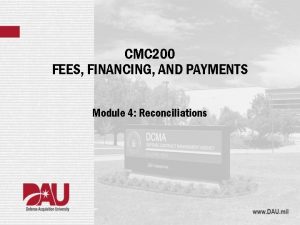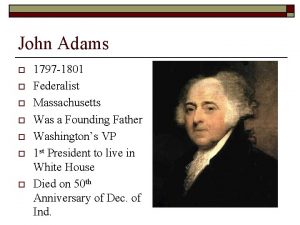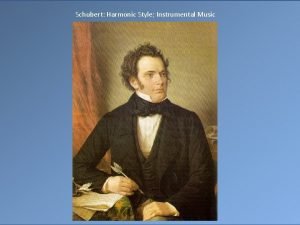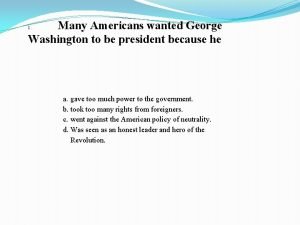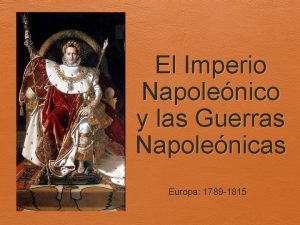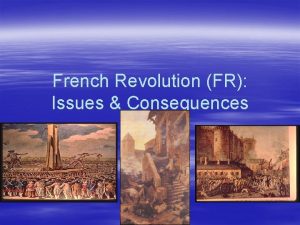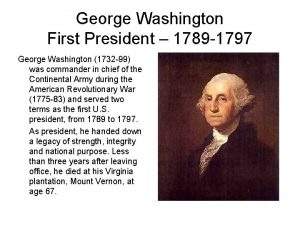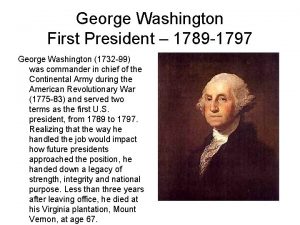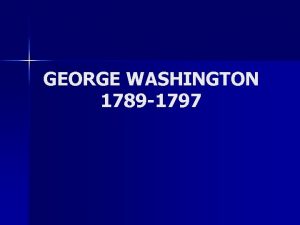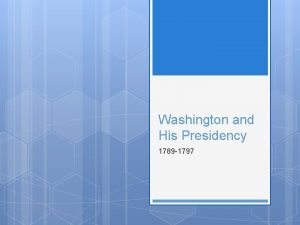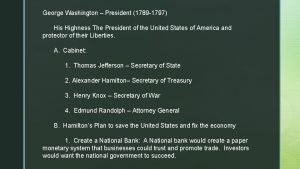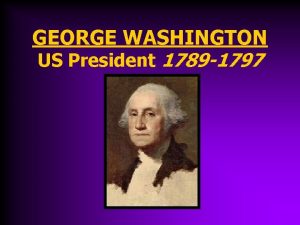President G Washington 1789 1797 April 30 1789








- Slides: 8

President G. Washington (1789 -1797) Ü April, 30, 1789 - Inaugurated in New York City (on Wall Street) Ü 57 years old Ü married to Martha Ü from Virginia Ü salve owner Ü only unanimously elected president Ü Vice President John Adams (very limited power - president of Senate)

President G. Washington (1789 -1797) 1 st Congress: Ü Established 3 executive departments Ü Treasury (Sec. Alexander Hamilton) Ü State (Sec. Thomas Jefferson) Ü War (Sec. Henry Knox) Ü Also created positions of: Ü Postmaster General Ü Attorney General (our nation’s chief law enforcement officer)

President G. Washington (1789 -1797) #1 Problem = Debt – owed to: Ü Foreign nations (such as Spain and France) Ü States (from war) Ü Citizens (bonds) Alexander Hamilton (Sec. of Treasury) - Became most powerful man in government Ü influenced by Adam Smith’s Wealth of Nations (1776) Ü $ circulation = economic growth - HOW? Ü Capitalism Ü Most businesses privately owned Ü Competition and free market determined prices and production. => SUPPLY+DEMAND

President G. Washington (1789 -1797) Hamilton’s Plan: Ü Assume state debts (to help stimulate local economies) Ü Tariffs (as the main source of govt. income & to promote American businesses) Ü National Bank (stabilize currency and encourage circulation) Ü Arguments against/for: Ü STRICT CONSTRUCTION Madison and Jefferson opposed National Bank, said it was unconstitutional (not an enumerated power) Ü LOOSE CONSTRUCTION Hamilton invoked elastic clause saying it was “necessary and proper” (implied power) Jefferson demanded the capital be in the South (settled dispute)

President G. Washington (1789 -1797) Ü Challenges in the Trans-Appalachian West Ü “Indians” Ü Resisted Ohio Valley settlement & wanted own nation Ü Helped British maintain forts Ü Battle of Fallen Timbers (Ft. Miami) - Anthony Wayne Ü Treaty of Greenville

President G. Washington (1789 -1797) Ü Challenges in the Trans- Appalachian West Ü British Ü Kept forts in Ohio Valley Ü Jay’s Treaty (1794) Ü After victory at Fallen Timbers Ü Got British out of new territory Ü Opened trade to West Indies Ü Spain Ü Claimed all of western N. America Ü Controlled New Orleans Ü Incited local Indians against U. S. Ü Pinkney’s Treaty 1795 Ü Opened the Port of New Orleans for deposit and navigation of the Mississippi River Ü Spain also agreed to stop inciting local Indians

President G. Washington (1789 -1797) Ü Challenges in the Trans-Appalachian West Ü Western Settlers Ü Tended to be antifederalists Ü Resisted taxes & Gov. control Ü Whiskey Tax (1794) –Hamilton Ü => Whiskey Rebellion (Western Pennsylvania) Ü tax collectors chased away & tarred & featheredÜ Hamilton convinced Washington to send in troops (major controversy!) Ü Peaceful resolution

President G. Washington (1789 -1797) Ü Another challenge = French Revolution Ü Divided Americans Ü Revolution took violent and radical turn Ü Hamilton and many wanted to keep good trade relationship with British - supported defeat of the revolutionaries Ü Others supported the French people and their fight for freedom from the monarchy Ü Washington = NEUTRAL Ü 1794 British began seizing US merchant ships in West Indies and began the practice of “impressment” Ü This led to the eventual creation of the best, fastest, navy on the seas

